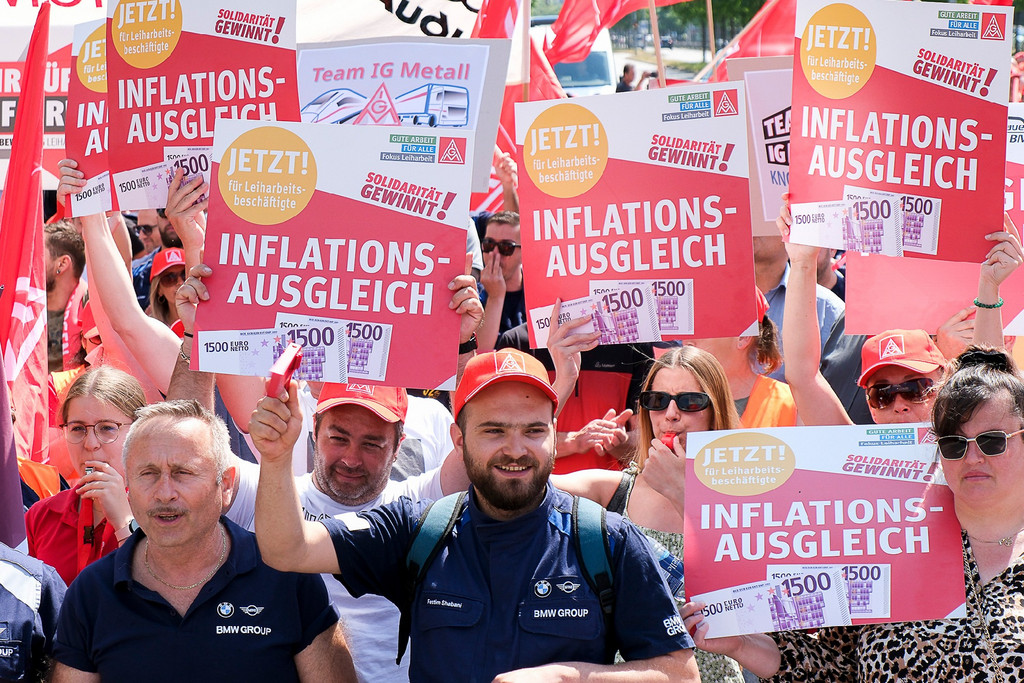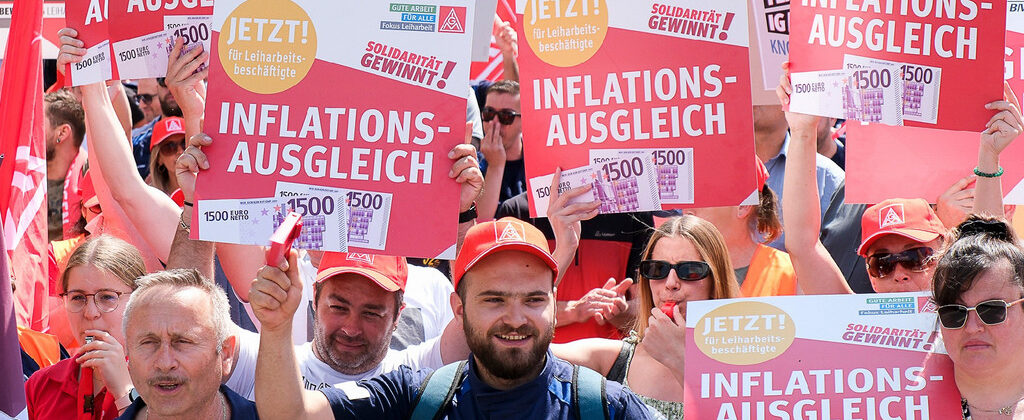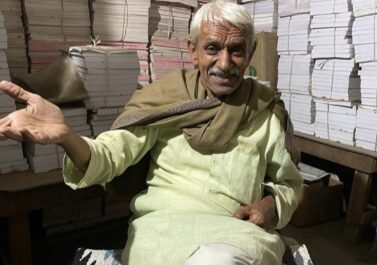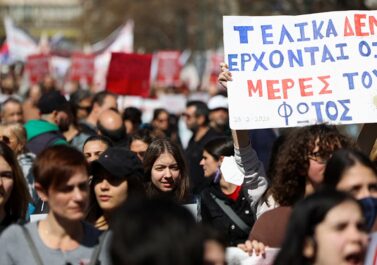
Translated from: analyse & kritik, Zeitung für linke Debatte & Praxis, No. 705, June 18, 2024
There are enough poor people in rich Germany – but why is it still so quiet here?
By Christian Frings
When the inflation rate in Germany skyrocketed from March 2022 and for a short time – from September 2022 to February 2023 – was almost nine percent, right-wing extremists saw new opportunities for their coup plans, and even the Foreign Minister warned of “popular uprisings” in the fall. This also startled some left-wing forces, who suddenly discovered the “social question” – not because the debate about a “new class policy” that had been lost during the coronavirus crisis had borne fruit, but in order to pre-empt right-wing mobilizations. As interesting as some of these attempts were (an overview and critique can be found in the volume “KlassenLos”, ak 698), the attention quickly fizzled out again when the government took the pressure off the boiler with three social policy relief packages and inflation also began to fall again in spring 2023.
From September 2022, the European Central Bank began to raise key interest rates to curb inflation. This intervention was reminiscent of the interventions by central banks during the financial crisis of 2007/2008, which at the time gave the impression of global control and dashed hopes of revolutionary developments in the Global North. Marx once called the banking system “the most artificial and developed product that the capitalist mode of production can produce”, i.e. the highest possible level of consciousness with which the ruling class can intervene in the self-running economic cycle. By this Marx by no means meant that the fetishistic and reified character of capitalist momentum had been overcome – otherwise bubbles would not have to burst. But in a global financial system with the (still) single reserve currency of the US dollar, there is the possibility of monetary policy corrections, which was also demonstrated during the short winter of inflation. In addition, inflation rates of almost ten percent are threateningly high by local standards, but a far cry from the horrors of inflation in countries in the Global South such as Zimbabwe (660 percent), Venezuela (330), Sudan (170), Argentina (130) or Turkey (over 50).
“Deserving and undeserving poor”
This juxtaposition reminds us that, in addition to monetary policy interventions, it was above all the financial leeway of a rich country that made it possible to prevent major unrest through social policy measures. Since its first beginnings at the end of the 19th century, the welfare state’s containment of class conflict in this country has been based on the colonial (now neo-colonial) exploitation of the South and aims to divide the proletariat within the countries of the North. The former makes it possible to “gild” the invisible chains with which we are bound to capital, as Marx called it, or to make them bearable through an “imperial mode of living”, as is rightly scandalized today in the context of the ecological crisis.
However, as the court report in this issue impressively demonstrates, even in this country people without the means of production enjoy this mode of living to very different degrees. The welfare state, which was launched in Germany in 1881 in the wake of the Paris Commune of 1871, aimed from the outset to discipline and control the proletariat, to atomize it through juridification and to divide it into different categories. It is precisely these mechanisms and divisions that make it so difficult or even impossible for protests or uprisings by “poor people” to take place today.
One of the most important divisions is the traditional distinction between “deserving” and “undeserving”, i.e. “self-inflicted” poverty, which is expressed today in the separation between social insurance (today’s unemployment, pension, and health insurances) and relief (today’s income support, called “Hartz IV” or now “Bürgergeld” in Germany), which, unlike insurance, is dependent on a means test. At the beginning of social legislation, this contrast offered itself as a line of compromise with the early, male-dominated labor movement, which had formed not only in opposition to capital, but also in distinction to the lower strata of the proletariat, often denounced as the “lumpenproletariat”. The construction of social benefits for people who do not work or can no longer work and thus earn “their own” money as insurance ties in with what Marx criticized as the decisive cover-up of exploitation – the fetishism of the wage form, which makes us believe that wages are a fair exchange of work for money, while in reality we are only fed with them in order to reproduce our ability to work for exploitation. Because if I receive benefits from an “insurance scheme”, I can imagine that these come from the “contributions” I have saved up myself, i.e. that they are not “alms”. This maintains the illusion that I, as an exploited person, am still an independent owner of a commodity (the commodity of labor) like everyone else in bourgeois society even in a state of need – and in no way receive anything as a “gift” from the state, like people living on charity.
Riot – strike – riot?
Parallel to the introduction of social insurance, the establishment and legal protection of trade unions developed as the representation exclusively of this part of the proletariat, the “wage laborers”, who can proudly point out that they live from “their own hands’ honest work”. In the early days of modern mass trade unions after the largely spontaneous Europe-wide strike wave between 1889 and 1891, they were referred to as “strike prevention associations” by more critical minds in the workers’ movement. This was because the monopoly granted to them by the state and capital on the form of struggle of the strike in conjunction with peacemaking collective agreements was intended to put an end to the wild goings-on of work stoppages, factory occupations, sabotage and riots on the streets. Although it took two world wars, fascism and the Cold War for this model to become effectively established in the Global North, it still works quite well today with the very moderate use of strikes.
In his book “Riot.Strike.Riot” (ak 669), Joshua Clover attempted to classify the two forms of struggle, strike in the workplace and riot in the streets, into a chronological sequence that corresponds to different phases of capitalist accumulation, in which either circulation (riot) or production (strike) are at the center. In her critique of this schema, Amanda Armstrong (ak 670), based on her research on strikes on the British railroads at the turn of the 19th and 20th centuries, showed that this separation does not apply to the history of mass strikes before they were contained by the welfare state. The strikes of that time were always accompanied by actions by people from the surrounding proletarian neighborhoods, who supported the strikers with road and rail blockades, looting of warehouses and battles with the police, but were also able to assert their own concerns. Throughout the history of modern capitalism, strikes have therefore repeatedly opened up spaces for other “poor people” and offered opportunities to fight for their interests even without their own productive power, to break out of the loneliness of courtrooms and the clutches of a paternalistic administration of poverty.
This is why the regulation of conflicts in wage labor under collective bargaining law is so important for political stability in the metropolises – only with them can a clear dividing line be drawn between threatening gestures of social partnership, which today are referred to as strikes, and such upheavals of everyday life that frighten “the good citizens” as riots. Anyone who has ever been involved in a strike knows that even in trade union strikes, however regulated and controlled, there are moments of stepping out of the hamster wheel, the creation of new social relationships and the joy of reversing the balance of power at the shop floor. For precisely this reason, strikes must not happen too often, must not last too long and must never become an expression of the antagonistic conflict inherent in the very class relation due to an “disproportionate” scale of the social disruption.
The allure of the premium
In this respect, one component of the relief packages with which the German government responded to inflation concerns played a special role: the tax-free inflation compensation bonus of a maximum of 3,000 euros, which employers can pay out to their employees until the end of 2024. In the past, the fact that collectively agreed wages have lagged behind inflation has often led to wildcat strikes, such as in 1969 or 1973, to push through inflation bonuses or to unions coming under pressure to risk more extensive strikes. The bonus, which was gratefully taken up by employers’ associations and trade unions alike and incorporated into the new collective agreements, was aimed at this risk of heated wage disputes. By mid-March 2024, more than three quarters of employees covered by collective agreements had received the bonus or will receive it by the end of 2024. It is clear within the unions that this is a poisoned gift, as the companies can use this one-off payment to prevent long-term pay rises that affect the pay scale and the bonus has no effect on pensions. But the attraction of being able to take the pressure off collective bargaining with a few thousand euros as “cash on the spot” was simply too great.
If, on the other hand, “an intensification of struggle, aiming to make it all stop” (Armstrong) would happen with the simultaneous indefinite mass strikes on trains, buses and airports, which seemed within reach in this spring, then spaces for protests would have opened up for other “poor people” and encouraged them to take action. Instead, we can now wait for the next restrictions on income supports (Bürgergeld), as already announced by the Christian Democratic and Liberal parties.



